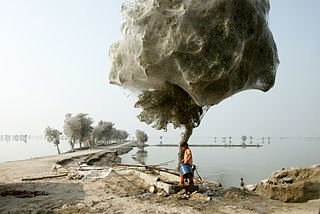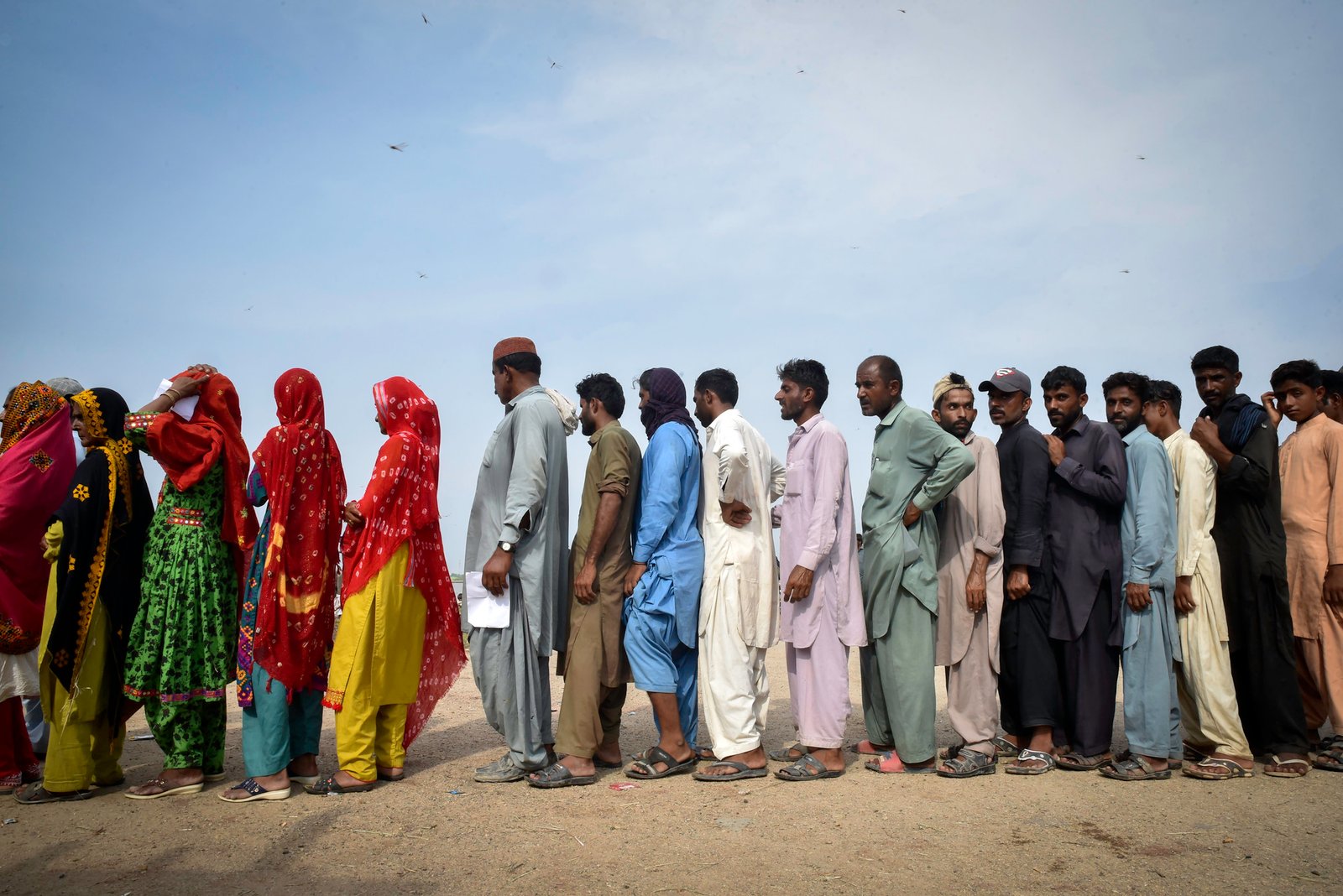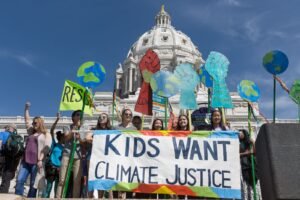Meses após as inundações recorde atingirem o Paquistão, a recuperação ainda parece distante. As agências de ajuda humanitária afirmam que pode levar meio ano para que as águas das enchentes recuem completamente, já que algumas partes da província de Sindh, em particular, ainda estão submersas. Até agora, mais de 1.700 pessoas foram mortas e mais de 33 milhões foram impactadas. O governo e os trabalhadores humanitários também estão respondendo e se preparando para os desafios de saúde, alimentação e infraestrutura à medida que surgem. Inicialmente, tratava-se de adquirir e fornecer barracas e água potável, mas à medida que a crise se aproxima da marca de meio ano, as necessidades se expandiram e incluem equipamentos como instalações para mulheres no final da gravidez e cuidados veterinários para o gado dos quais muitos deslocados rurais dependem. Depois de apresentar inicialmente uma estimativa de US$ 30 bilhões em danos relacionados às inundações, o governo do Paquistão revisou recentemente sua estimativa para US$ 40 bilhões.
Sherry Rehman, ex-jornalista e senadora que no início deste ano assumiu o cargo de Ministra das Mudanças Climáticas, falou abertamente sobre onde está a responsabilidade pela crise em andamento. Em uma entrevista recente ao Guardian, ela observou a disparidade entre o quão pouco países do sul global, como o Paquistão, contribuem para a mudança climática global e quão severamente eles sofrem com os impactos das mudanças climáticas, como eventos extremos. Ela trouxe o assunto das reparações, observando: “Há tantas perdas e danos com tão poucas reparações a países que contribuíram tão pouco para a pegada de carbono do mundo que fica claro que a barganha feita entre o norte global e o sul não está funcionando.” Além disso, ela chamou esses eventos de “desastres causados pelo homem” e declarou que “as injustiças históricas precisam ser reconhecidas”.

Em 2010, as aranhas escaparam das inundações subindo em árvores, onde teciam teias fantasmagóricas no tempo que levou para a água recuar. (Foto por DFID – UK Department for International Development)
Ativistas, acadêmicos e funcionários do governo do Paquistão e de todo o mundo pediram reparações após o desastre em curso. Esses apelos, obviamente notáveis agora, pois vêm de um ministro de mudanças climáticas em exercício de um país inundado, não são novos. O conceito de reparações tem suas raízes modernas no direito internacional. Após a Primeira Guerra Mundial, a Alemanha e seus aliados foram obrigados pelo Tratado de Versalhes a dar reparações de guerra às Potências Aliadas, pois o Artigo 231 afirmava que as nações derrotadas deveriam aceitar a responsabilidade pelas perdas e danos sofridos pelas nações vitoriosas ao longo da guerra. A partir da segunda metade do século 20, as reparações também passaram a fazer parte do processo de justiça de transição por meio do qual as vítimas de violações de direitos humanos podiam exigir reparação do governo ou grupo que cometeu as violações. Notavelmente, descendentes de escravos em países como Brasil e Estados Unidos usaram o quadro de reparações para exigir responsabilidade, terra e compensação de seus respectivos governos.
Os apelos por reparações climáticas são baseados nos esforços intelectuais, legais e políticos dessas elaborações anteriores e em andamento. Antes, talvez seja útil discutir o que os defensores críticos argumentam que não são reparações. Governos e instituições do norte global, como as Nações Unidas, o Banco Mundial e o Fundo Monetário Internacional, geralmente são rápidos em oferecer ajuda e empréstimos após um desastre. No entanto, ativistas críticos não veem isso como uma versão ou substituição das reparações. Ativistas no Paquistão, como o acadêmico Aasim Sajjad Akhtar, e grupos globais do norte, como a Debt Justice, têm defendido a compreensão dos empréstimos, principalmente de organizações como o FMI, como uma forma de colonialismo contemporâneo. Esses empréstimos geralmente vêm com condições e estipulações para reestruturar indústrias, remover proteções sociais e até remodelar toda a economia. Muitos que vivem em países receptores de empréstimos do sul global apontam que essas estipulações reforçam o fundamentalismo de livre mercado de tal forma que beneficia atores poderosos nos países desenvolvidos, às custas de comunidades vulneráveis e marginalizadas. O proeminente economista paquistanês Mahbub ul-Haq, que liderou o desenvolvimento do Índice de Desenvolvimento Humano (IDH) enquanto esteve na ONU, alerta: “Os mercados não são muito amigáveis com os pobres, os fracos, os vulneráveis… mas sim a serviço de poderosos grupos de interesse.”
Da mesma forma, os ativistas argumentam que a ajuda e o socorro pós-desastres são ineficazes, equivocados e simplesmente insuficientes. Um exemplo notável disso está na ajuda da Agência dos Estados Unidos para o Desenvolvimento Internacional ao Haiti após o terremoto devastador de 2010. Não só as forças de paz da ONU causaram uma epidemia de cólera no Haiti, mas enormes quantidades de ajuda de fontes privadas e governamentais na verdade não chegaram para as vítimas haitianos. Desde 2010, a Agência dos Estados Unidos para o Desenvolvimento Internacional concedeu US$ 2,8 bilhões em contratos e doações para recuperação no Haiti, dos quais apenas 3% foram diretamente para organizações e empresas do país. Os defensores das reparações argumentam que não é suficiente colocar um curativo único em uma ferida aprofundada ao longo de décadas e séculos por roubo colonial, medidas de austeridade impostas por empréstimos e degradação climática global, tudo nas mãos de países ricos do norte global .
As reparações climáticas não consistem em ajuda imediata pós-desastre, mas sim mudanças sistêmicas que redistribuem recursos e poder. Não se trata apenas de inclusão, porque mesmo quando um país altamente impactado pelo clima, como Paquistão ou Fiji, é convidado a participar ou mesmo liderar alguma iniciativa da ONU, as regras e, mais importante, os recursos ainda estão muito nas mãos das nações ricas menos impactadas pelo clima. O que é preciso é mudar políticas e instituições que criaram desigualdades e impediram mudanças significativas. O filósofo americano Olúfẹ́mi Táíwò, da Universidade de Georgetown, defende a visão das reparações como um projeto de construção de mundo, que desafia entendimentos e realidades fundamentais do mundo em que vivemos atualmente. Uma área que deve mudar, segundo Táíwò, é o policiamento das fronteiras nacionais e o regime internacional de refugiados. Ele e a coautora Beba Cibralic escrevem: “Com essa nova abordagem, a comunidade internacional rejeitaria o enquadramento da política de refugiados como apenas resgate e repensaria a estrutura que permite aos estados confinarem refugiados em campos com aprovação internacional”. O norte global teria que assumir maior responsabilidade por seu papel da exploração econômica e da degradação ambiental, ou seja, em tornar regiões do planeta inabitáveis. Táíwò argumenta que em um mundo de impactos diferenciados, as reparações climáticas devem tratar de identificar e abordar como essas diferenças surgiram. Nesse sentido, ele une o comércio global de escravos, encarceramento, justiça alimentar, igualdade de moradia e muito mais na conversa sobre mudanças climáticas.
As reparações climáticas reconheceriam de maneira tangível que o Império Britânico roubou US$ 45 trilhões da Índia, projetos de desenvolvimento internacional pós-independência liderados pelos EUA e Europa e medidas de austeridade impostas por empréstimos tiveram no afogamento do Paquistão neste verão. Isso tiraria o dinheiro da ajuda das mãos dos contratados da USAID e o colocariam nas mãos das comunidades impactadas. Em sua essência, as reparações são sobre dinheiro – Táíwò observa que as transferências incondicionais de dinheiro são o padrão-ouro das reparações – mas, ao mesmo tempo, deve ser muito mais. Os países do sul global vulneráveis ao clima precisam de mais do que abrigos de curto prazo, precisam de um reconhecimento significativo das intrincadas e complexas maquinações de séculos de colonialismo e exploração, e precisam de toda uma reviravolta e redistribuição do poder global.
English Version
Pakistan Floods and the Case for Climate Reparations
Months after record-setting floods hit Pakistan, recovery still looks far away.
Relief agencies have stated that it may take half a year for floodwaters to fully recede, as some parts of Sindh province in particular are still underwater. Thus far, over 1,700 people have been killed and over 33 million have been impacted. The government and relief workers are also responding to and preparing for health, food, and infrastructure challenges as they emerge. Initially it was about procuring and providing tents and clean water but as the crisis approaches the half-year mark, the needs have expanded and include things such as facilities for women late in pregnancy and veterinary care for livestock that many rural displacees rely upon. After initially submitting an estimate of $30 billion in flood-related damages, the government of Pakistan recently revised their estimate up to $40 billion.
Sherry Rehman, a former journalist and senator who earlier this year stepped into the role of Minister of Climate Change, has been outspoken about where the responsibility lies for the ongoing crisis. In a recent interview with the Guardian, she noted the disparity between how little global south countries like Pakistan contribute to global climate change and how severely they are impacted by climate change’s impacts such as extreme weather. Most notably, she brought up the subject of reparations, noting, “There is so much loss and damage with so little reparations to countries that contributed so little to the world’s carbon footprint that obviously the bargain made between the global north and global south is not working.” Furthermore, she called these events “man-made disasters” and declared that “historic injustices have to be heard.”

In 2010, spiders escaped flooding by climbing into trees, where they wove ghostly webs in the time it took for the water to recede.
(Photo by DFID – UK Department for International Development)
Activists, scholars, and government officials from Pakistan and around the world have called for reparations in the aftermath of the ongoing disaster. These calls, of course notable now as they come from a sitting climate change minister of a flooded country, are not new. The concept of reparations has its modern roots in international law. After World War I, Germany and its allies were required by the Treaty of Versailles to give war reparations to the Allied Powers as Article 231 stated that the defeated nations must accept responsibility for the loss and damage suffered by the victorious nations over the course of the war. Beginning in the second half of the 20th century, reparations also became part of the transitional justice process through which victims of human rights violations could demand redress from the government or group that carried the violations out. Notably, descendents of slaves in countries such as Brazil and the United States have used the framework of reparations to demand accountability, land, and compensation from their respective governments.
Calls for climate reparations stand on the shoulders of the intellectual, legal, and political efforts of these previous and ongoing efforts. Perhaps first, it is helpful to discuss what critical advocates argue is not reparations. Global north governments and institutions such as the United Nations, the World Bank, and the International Monetary Fund are often quick to offer aid and loans in the aftermath of a disaster. However, critical activists do not see this as a version of or replacement for reparations. Activists in Pakistan like the scholar Aasim Sajjad Akhtar and global north-based groups such as Debt Justice have argued for understanding loans, particularly to organizations such as the IMF, as a form of contemporary colonialism. These loans often come with conditions and stipulations to restructure industries, remove social protections, and even reshape the entire economy. Many living in global south loan-recipient countries point out that these stipulations enforce free market fundamentalism in such a way that benefits powerful actors in developed countries, at the expense of vulnerable and marginalized communities. The preeminent Pakistani economist Mahbub ul-Haq, who led the development of the Human Development Index (HDI) while at the UN, warned, “Markets are not very friendly to the poor, to the weak, to the vulnerable… The markets are often the handmaiden of powerful interest groups.”
Similarly, activists have also argued that post-disaster aid and relief is ineffective, misguided, and simply not enough. A notable example of this is in the United States Agency for International Development’s aid to Haiti in the aftermath of the devastating earthquake in 2010. Not only did UN peacekeepers cause a cholera epidemic in Haiti, enormous amounts of aid from both private and governmental sources did not actually go to Haitians reeling from their recent disaster. Since 2010, the United States Agency for International Development has awarded $2.8 billion in contracts and grants for recovery in Haiti, of which only 3% has gone directly to organizations and companies in the country. Crucially, advocates of reparations argue that it is not enough to place a one-time bandage across a wound deepened over decades and centuries by colonial theft, loan-enforced austerity measures, and global climate degradation, all at the hands of wealthy global north countries.
Climate reparations are not immediate post-disaster aid but rather systemic changes that redistribute resources and power. It is not simply about inclusion, because even when a highly climate-impacted country such as Pakistan or Fiji is invited to participate or even lead some initiative of the UN, the rules and most importantly the resources are still very much in the hands of the much less climate-impacted wealthy nations. It is about changing policies and institutions that have created inequalities and prevented meaningful change. American philosopher Olúfẹ́mi Táíwò of Georgetown University argues for viewing reparations as a worldmaking project, one that challenges fundamental understandings and realities of the world in which we currently live. One area that Táíwò argues must change is the current enforcement of national borders and the international refugee regime. He and co-author Beba Cibralic write, “With this approach, the international community would reject the framing of refugee policy as rescue and rethink the framework that allows states to confine refugees in camps with international approval.” The global north would have to take greater responsibility for its role, through economic exploitation and environmental degradation, in making parts of the planet uninhabitable. Táíwò argues that in a world of differentiated impacts, climate reparations must be about identifying and addressing how those differences came to exist. In that sense, he links together the global slave trade, incarceration, food justice, housing equality, and more into the conversation about climate change.
Climate reparations would recognize in a tangible way the role that the British Empire stealing $45 trillion from India, post-Independence international development projects led by America and Europe, and loan-enforced austerity measures have had in drowning Pakistan this summer. It would take aid money out of the hands of USAID contractors and into the hands of impacted communities. At its core, reparations is about money – Táíwò notes that unconditional cash transfers are the gold standard of reparations – but at the same time, it must be about so much more. The climate-vulnerable countries of the global south need more than short-term shelters, they need a meaningful recognition of the intricate and complex machinations of centuries of colonialism and exploitation, and they need an entire upheaval and redistribution of global power.


























